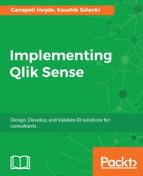In this architecture, QVD layer has been added. Instead of using a direct connection to database for dashboard designing, the data is stored in QVD first and then QVDs are used to load the data into QVF, which is used to create visualization.
Architecture contains two additional layers, which are as follows:
- Extraction layer: In this we create an extraction layer by writing QVF applications which connect to data source tables and create QVD. The QVF will not be used to create visualization. The sole purpose is to take an extract of database table and store into QVD.
You can also do the transformation of data or apply business logics before storing the data into QVD.
- QVD layer: The QVDs which are created using the extraction layer will be used to load data into the dashboards.
The following diagram shows a two tier architecture:

Two Tier QVD Architecture.
The advantage of using this architecture over one tier architecture is that it allows re-usability and consistency of data. Also, the fetching of data can be scheduled during non-peak works thereby reducing impact on source systems.
